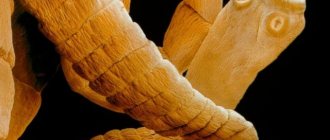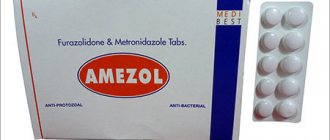Who is the wide tapeworm?
Diphyllobothrium latum is a tapeworm ranging from 2 to 10 meters in length. Some specimens exceed this length. The wide tapeworm belongs to the class of cestodes (Cestoda), family Diphyllobothriidae. It consists of a neck, on which there is a scolex (head) with two slit-like devices for attaching the helminth to the mucous membrane of the small intestine, and a body.
The body of the tapeworm consists of a huge number of segments, their number reaches 4 thousand. Large oval-shaped eggs are formed in mature segments. They are protected by a two-layer shell and have a cap on one of the poles. While in the intestines of the intermediate or definitive host, the tapeworm secretes immature eggs that reach full maturity only in fresh water.
Structure
The adult tapeworm worm consists of three rather different morphological segments: the scolex (head), neck (proliferative region) and lower body. The head is small - 3-5 mm long, about 1 mm wide. It is oblong, oval, flattened on the sides. Each side of the scolex has slit-like grooves called bothria that are designed to attach to the intestine.
Behind the head is a thin neck. The scolex is attached to it. Many segments (proglottids) grow from the neck, which contain the genital organs of the worm. The number of these proglottids can reach more than 3000 in an adult. And they are all wider than they are long – hence the name “Wide Tape.”
The eggs are yellow, oval-shaped (like a chicken's), and relatively large. At one pole there is a cap for hatching the larvae, at the other there is a small tubercle.
The broad tapeworm, like other tapeworms, has a hermaphroditic reproductive system. It is represented by male genital organs - numerous spherical testes, and female ones - bilobed ovaries, vitelline and uterus. The testes and vitelline sacs are located on the sides of each segment, and the uterus and ovaries are in the center.
The vas deferens emerges from the testes on the ventral side of each proglottid, which opens outward in its anterior part. In addition to this opening, each segment has two more - the vagina and the uterus. The vagina opens near the male duct and together with it they form the copulatory apparatus - the cirrus, which is located in the muscle sac (bursa).
The segments (proglottids) can mate either crosswise or within one such segment. Reproduction begins approximately when there are more than 60 of them from the head.
The broad tapeworm is the longest among all tapeworms (tapeworms) in the human body. Its average length is 10 m, some individuals reach up to 15 m. Adult parasites can produce up to a million eggs per day!
Symptoms of diphyllobothriasis
From the moment the tapeworm enters the human body until the first significant symptoms appear, it can take from 20 to 60 days. Manifestations of the disease develop gradually and may be mild for a long time.
Symptoms of infection:
- Nausea, vomiting;
- Abdominal pain of a cramping nature;
- Increased salivation (hypersalivation);
- Fatigue;
- A slight increase in temperature to subfebrile levels;
- Decreased or increased appetite, weight loss;
- Alternating constipation and diarrhea;
- The appearance in feces of fragments of the body of the tapeworm in the form of scraps of whitish ribbons;
- Intestinal obstruction due to the accumulation of helminths in the lumen of the small intestine;
- Signs of anemia with vitamin B12 deficiency (weakness, tachycardia, dizziness, pale skin, swelling of the face, arms and legs, cracked tongue, atrophy of taste buds, damage to the oral mucosa);
- Damage to the nervous system (numbness of the limbs, sensory disturbances, unsteady gait);
- Blood composition disorders (decrease in the number of leukocytes, erythrocytes, platelets, blood hemoglobin, increase in color index, appearance of megaloblasts, megalocytes).
The intensity of symptoms depends on the degree of damage to the body, concomitant pathologies, and diet. In severe cases, hepatomegaly, enlarged spleen, and extremely low secretion of gastric juice are noted. The accumulation of many helminth individuals in the intestinal lumen leads to obstructive intestinal obstruction. There are cases of latent (hidden) infection.
Symptoms
In the vast majority of cases, patients experience an asymptomatic or mild form of diphyllobothriasis (pathology caused by infection of the broad tapeworm). However, in this case, the appearance of segments of the parasite in the feces is observed. In the case of an obvious course of the disease, the main manifestations appear after approximately two months. A person infected with worms experiences:
- abdominal pain resembling cramps;
- increased salivation;
- nausea;
- appetite disorders - its increase, alternating with a complete lack of desire to eat any food;
- losing weight with proper nutrition;
- anemia;
- inflammation of the tissues of the tongue (glossitis).
Immediately after the wide tapeworm enters the intestines, disorders of the digestive processes are observed. Then pain appears after eating. With severe helminthic infestation, the size of the liver and spleen increases. Prolonged presence of tapeworm in the body is accompanied by symptoms of anemia:
- weakness;
- decreased performance;
- increased heart rate;
- pain and dizziness;
- hypotension;
- paleness of the skin;
- fainting states.
Consequences of diphyllobothriasis for human health
Consequences of helminth presence in the human gastrointestinal tract:
- At the site of attachment of bothry of the tapeworm scolex to the intestinal mucosa, tissue necrosis and atrophic processes develop;
- Disturbances in the activity of the gastrointestinal tract occur due to damage to the nerve endings of the mucous membrane and disorders of intestinal trophism;
- The waste products of the broad tapeworm sensitize the body, causing allergic reactions;
- Megaloblastic anemia appears due to the fact that vitamins B1, B6, B12 are adsorbed by the parasite.
A severe form of anemia leads to neurological disorders: depression, increased irritability, hyperreflexia, paresthesia.
Preventive measures
Measures to prevent broad tapeworm infection include:
- use of protective gloves when preparing fish dishes;
- prevention of eating poorly salted, fried or boiled fish.
The death of parasite larvae occurs at a temperature of minus 55 °C. To avoid infection caused by their penetration into the body, fish should be fried for 10 minutes on each side, and large pieces for half an hour. When salting, the salt content in the finished product must be at least 9%. If infection does occur, you should immediately begin treatment, and after its completion, conduct a follow-up examination. This is explained by the fact that in some cases the therapeutic effect is not achieved immediately. The head of the parasite remains on the intestinal mucosa, and then, after some time, begins to produce segments and eggs again. In this case, repeated therapy is prescribed to completely destroy the broad tapeworm. It is necessary to treat diphyllobothriasis.
The broad tapeworm is a tape-shaped worm that parasitizes the human body, infecting the walls of the colon and causing a disease called diphyllobothriasis. The helminth goes through its life cycle of development, moving from one host to another.
Routes of infection with tapeworm
Infection with the broad tapeworm occurs through the nutritional route. Invasion of the parasite occurs during the consumption of infected fish or caviar, which may be lightly salted or insufficiently thermally processed. In the muscles or internal organs of such fish (chum salmon, pink salmon, pike perch, burbot, ruffe, pike) there is a plerocercoid - an intermediate form of development of the wide tapeworm.
It is most likely that such caviar or fish was salted at home in violation of the proportions or salting technology. Sometimes infection occurs through contaminated dishes, knives, and cutting boards. Those who prefer to eat fish or caviar raw or cook fish kebab are at great risk.
Parasite development cycle:
- From the small intestine of an infected person or animal, tapeworm eggs enter the external environment.
- In some of the eggs that fall into the water, a tapeworm embryo develops. If the water temperature does not drop below +15°C, the embryo (coracidium) emerges into open water after 1-2 weeks.
- At temperatures no higher than +20°C, it remains viable in fresh water for up to six months.
- In the body of a freshwater crustacean that has swallowed the embryo, it turns into a larva (procercoid).
- Predatory fish or fish of the chum family swallow crustaceans along with procercoids.
- In the body of fish, the larvae penetrate through the intestinal wall into the muscles and continue their development, transforming within a month into a plerocercoid measuring from 1 to 5 cm, together with bothria. This form of tapeworm development can be seen with the naked eye.
- The plerocercoid, together with the fish, enters the body of the final host (human) and continues its development in the small intestine.
- After 2-4 weeks, the larva turns into a sexually mature individual and begins a new development cycle.
From the egg stage to the appearance of a mature individual, under favorable circumstances, 6-7 months pass. In the human body, the broad tapeworm can parasitize for up to 20 years. A sexually mature female tapeworm is able to produce up to 2 million eggs per day.
In addition to humans, the final hosts of this parasite can be cats, dogs, pigs, foxes and bears. Although they intensively excrete parasite eggs along with feces, they are not directly dangerous to others, since the embryos have not developed to an invasive state.
Routes of entry into the human body
Broad tapeworm infection usually occurs when eating raw or improperly cooked fish. The parasite larvae living in rivers and lakes are not dangerous to humans and animals. When they penetrate the body, they mostly die without transforming into a full-fledged worm. Attention! In order for the parasite to survive, it needs to go through all larval stages in intermediate hosts. Thus, it is impossible to become infected from a sick person or representative of the fauna, as well as to become infected with the tapeworm yourself. Another route of infection with the parasite is considered to be contact with sick fish during cutting. That is why it is advisable to work with it in rubber gloves, and wash the knife and cutting board with hot water and disinfectant.
Treatment of diphyllobothriasis
Before treating diphyllobothriasis, the doctor diagnoses helminthiasis. A preliminary history of epidemiological manifestations is collected. It includes such items as living near a fresh body of water, fishing, and eating independently caught and salted fish.
Laboratory research:
- Fecal analysis to detect tapeworm eggs and parts of its body;
- Blood test to determine signs of hyperchromic anemia;
- Complete blood test to detect neuropenia and thrombocytopenia;
- Biochemical blood test for haptoglobin and lactate hydrogenase levels.
After analyzing all the indicators, the helminthologist recommends effective drugs for the treatment of diphyllobothriasis. At the preparatory stage, treatment for vitamin deficiency and iron deficiency anemia is carried out. For a month, the patient takes iron supplements and receives vitamin B12 injections.
Drugs with anthelmintic action:
- Praziquantel - leads to paralysis of the muscles of the parasite, is used to treat children from 4 years of age, the side effect is a decrease in concentration.
- Biltricide is contraindicated for pregnant women, dosage is 60-75 mg/kg body weight, the daily dose is divided into 3 doses.
- Niclosamide is used to treat children from 2 years of age (0.5 g/day), the therapeutic dose for adults and adolescents from 14 years of age is 2-3 g/day, accompanied by the use of laxatives.
To reduce the intensity of toxic poisoning and allergies, taking these drugs is accompanied by antihistamines - Tavegil, Suprastin, Cetrin, Diazolin.
How to get rid of an uninvited guest?
From the moment the diagnosis is established, treatment for tapeworm should begin as early as possible. To completely get rid of the parasite, a course of treatment is carried out, which is usually carried out on an outpatient basis. The patient is prescribed pathogenetic and specific drugs. If the anemia is significant, the doctor will prescribe folic acid tablets and intramuscular injections of vitamin B12 (cyanocobalamin) before choosing an anthelmintic medication. Specific therapy for tapeworm is drugs aimed at eliminating the parasite. Medicines in this group paralyze the neuromuscular system of helminths, which is why the parasite loses its ability to cling to the intestinal walls and is expelled by peristaltic waves.
Anthelmintics acting on tapeworm include:
- biltricide;
- fenisal;
- niclosamide;
- praziquantel;
- plant-based preparations (male fern seed extract, pumpkin seeds).
Of course, the drug, its dosage and timing of treatment should be chosen by a medical specialist based on the individual condition of the sick person, taking into account contraindications, since a number of drugs are contraindicated at certain stages of pregnancy, concomitant diseases, and young children.
We should not forget that in rare cases, part of the worm may remain in the intestines and begin to develop again, so after six months you should be tested again to ensure a final cure. If eggs and fragments of the broad tapeworm are again found in the biological material, then another course of treatment will have to be carried out. If the test results are negative, then further observation is not necessary.
To restore the body and correct the condition of the digestive system, enzymes, pro- and prebiotics, multivitamins, and antihistamines are used.
In general, the prognosis with timely diagnosis and adequate therapy is favorable.
Prevention of wide tapeworm infestation
To protect yourself from infection with Latena wide, you need to carefully monitor the complete culinary processing of fish: fry it for at least 30-40 minutes, salt it for 10 days, freeze fish products to destroy parasite larvae.
Fishermen and workers in the processing industry should undergo timely medical examinations, especially during the peak activity of parasite larvae. When the first symptoms of the disease appear, you should immediately undergo an in-depth examination by a parasitologist.
Author of the article:
Danilova Tatyana Vyacheslavovna |
Infectious disease specialist Education: in 2008, received a diploma in the specialty “General Medicine (Therapeutic and Preventive Care)” at the Russian Research Medical University named after N. I. Pirogov. I immediately completed an internship and received a diploma as a therapist. Our authors
Development cycle
The wide tapeworm is the largest helminth of all existing ones, its length can reach 20 m. It consists of a small (3-5 mm) head, neck and long body. The head has 2 slits with the help of which the tapeworm attaches to the intestinal walls of the final host.
The body of the parasite consists of many rectangular segments (proglottids), which bud from the neck and gradually move towards the end of the body, filling with eggs - oval-shaped capsules measuring up to 75 microns. When released along with feces, the eggs contaminate the environment, exposing people to the risk of diphyllobothriasis. One helminth is able to release up to 1 million or more eggs per day.
The broad tapeworm is a hermaphrodite. The female ovaries and male testes are located in each segment. The digestive system in its usual form is absent. Nutrients (semi-digested food, vitamin B12) are absorbed by the entire surface of the worm's body.
The life cycle of the tapeworm occurs with a change of several hosts. The final ones are carnivorous domestic and wild animals (dogs, bears, arctic foxes, foxes, etc.) and humans. In their body, the tape parasite grows from a larva to an adult capable of reproducing. First, freshwater crustaceans act as intermediate hosts, and then the fish that feed on them.
The entire cycle of transformations of the wide tapeworm looks like this. The segments with mature eggs that have come off the end of the helminth leave the intestines along with the feces. In order to develop further, the egg of the broad tapeworm must fall into the water, where the larva hatches from it. To move through water, it has cilia that constantly vibrate. The larva is swallowed by freshwater crustaceans (the first intermediate host), in whose body the parasite undergoes another molt. A fish that swallows an infected crustacean becomes a 2nd intermediate host. In it, the wide tapeworm develops into a plerocercoid - a worm-like larva 2-80 cm long, which is an invasive form for humans and animals.
Bibliography
- Centers for Disease Control and Prevention. Brucellosis. Parasites. Link
- Corbel MJ Parasitic diseases // World Health Organization. Link
- Young EJ Best matches for intestinal parasites // Clinical Infectious Diseases. — 1995. Vol. 21. - P. 283-290. Link
- Yushchuk N.D., Vengerov Yu.A. Infectious diseases: textbook. — 2nd edition. - M.: Medicine, 2003. - 544 p.
- Prevalence of parasitic diseases among the population, 2009 / Kokolova L. M., Reshetnikov A. D., Platonov T. A., Verkhovtseva L. A.
- Helminths of domestic carnivores of the Voronezh region, 2011 / Nikulin P. I., Romashov B. V.
An article for patients with a doctor-diagnosed disease. Does not replace a doctor's appointment and cannot be used for self-diagnosis.
The best stories from our readers
Topic: Parasites are to blame for all troubles!
From: Lyudmila S. ()
To: Administration Noparasites.ru
Not long ago my health condition worsened. I began to feel constant fatigue, headaches, laziness and some kind of endless apathy appeared. Problems also appeared with the gastrointestinal tract: bloating, diarrhea, pain and bad breath.
I thought it was because of the hard work and hoped that it would go away on its own. But every day I felt worse. The doctors couldn’t really say anything either. Everything seems to be normal, but I feel like my body is not healthy.
I decided to go to a private clinic. Here I was advised, in addition to general tests, to get tested for parasites. So in one of the tests they found parasites in me. According to doctors, these were worms, which 90% of people have and almost everyone is infected, to a greater or lesser extent.
I was prescribed a course of antiparasitic medications. But it didn’t give me any results. A week later, a friend sent me a link to an article where some parasitologist shared real tips on fighting parasites. This article literally saved my life. I followed all the advice that was there and after a couple of days I felt much better!
Digestion improved, headaches went away and the vital energy that I so lacked appeared. To be sure, I took the tests again and no parasites were found!
Anyone who wants to cleanse their body of parasites, no matter what types of these creatures live in you, read this article, I’m 100% sure it will help you! Go to article>>>
Still have questions? Ask them in our Anonymous group on VK
How to get rid of parasites in a week. The answer is here!
A reliable and effective remedy for combating worms. Removes all parasites in 21 days.
Go to website
Reviews
Read online
Symptoms that 100% indicate parasites! Take the Test.
How to rid your body of life-threatening parasites before it’s too late!
Read more
Website
To get a consultation
The doctor tells how to quickly get rid of parasites for adults and children!
A parasitologist explains what effective methods exist to combat helminths.
More details
Read completely
Comments
Search for cures for parasites
This service is a small help in finding cures for parasites. To start using it, select the type of parasite. If you don’t know what kind of parasite you are infected with, this parasite identification tool will help you by symptoms.
We recommend reading
Migratory larva Larva migrans: Cutaneous form, prevention, treatment
5 days ago 02.24.202124.02.2021ecoliv94
A child grinds his teeth in his sleep: is it worms? And what other reasons are there?
01/29/202102/01/2021ecoliv94
Worms from sushi and rolls: can they appear and how not to get infected?
01/09/202111/01/2021ecoliv94
Worms on ultrasound: what worms look like in the abdominal cavity, liver on ultrasound
01/09/202111/01/2021ecoliv94
Diagnostics
A reliable diagnosis of diphyllobothriasis can only be made using modern serological blood tests. It is impossible to accurately determine the presence of the disease based on symptoms, since the symptoms observed with this infection can also be attributed to other diseases. Even contact with raw fish is not always the determining factor in the diagnosis of this disease.
To accurately determine the presence of a tapeworm in the body, you need to resort to laboratory tests.
Diagnosis of the disease is carried out using the following methods;
- PCR - diagnostics. This research method is based on the principles of molecular biology. The principle of the study is to replicate the DNA and RNA of the parasite in the material being studied (in this case, blood). This method is very informative because it allows you to detect the DNA of parasites in the material, which indicates their presence in the body.
- Stool analysis (coprogram). Fragments of the tapeworm, its segments or eggs can be found in the feces, which eloquently indicates the presence of the parasite in the body.
- ELISA is a test based on immunological principles that allows you to identify specific proteins (antibodies) to parasite antigens in the body.
Additional non-specific research methods include:
- a blood test in which thrombocytopenia, anemia, eosinophilia, neutropenia and increased ESR (erythrocyte sedimentation reaction) are observed;
- biochemical blood test, which reveals a decrease in protein and albumin levels.
Why is it dangerous for humans?
The wide tapeworm negatively affects humans due to the release of waste products, mechanical damage to the intestines, impaired absorption of nutrients and vitamins, as well as the development of allergic reactions.
The consequences of diphyllobothriasis can be:
- Glossitis (inflammation of the tongue).
- Astheno-neurotic syndrome.
- B12 deficiency anemia.
- Enlarged liver and spleen. Observed in severe forms of the disease.
- Impaired secretion of gastric juice.
- Mechanical intestinal obstruction. It occurs due to blockage of the lumen of the human small intestine by helminths.
- Paresthesia (sensory disorders).
- Depression.
- Anaphylactic reactions.
- Hypovitaminosis.
The consequences of diphyllobothriasis may be liver enlargement.
The consequences of the disease may be Hypovitaminosis.
Astheno-neurotic syndrome can manifest itself after an illness.







